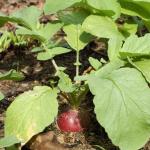Growing Radish
Raphanus sativas : Brassicaceae / the mustard or cabbage family
| Jan | Feb | Mar | Apr | May | Jun | Jul | Aug | Sep | Oct | Nov | Dec |
|---|---|---|---|---|---|---|---|---|---|---|---|
| P | P | P | P |
(Best months for growing Radish in USA - Zone 5a regions)
- P = Sow seed
- Easy to grow. Sow in garden. Sow seed at a depth approximately three times the diameter of the seed. Best planted at soil temperatures between 8°C and 30°C.
- Space plants: 3 - 5 cm apart
- Harvest in 5-7 weeks.
- Compatible with (can grow beside): Chervil, cress,lettuce, leeks, spinach, strawberries, tomatoes
- Avoid growing close to: Hyssop, gherkins
Small, spicy tasting root vegetable usually round but some longer varieties. Available in a range of colours between red and white.
Very easy to grow. Good for a child's first garden as seedlings appear in two or three days. Sow between other vegetables as they will mark the rows until the slower germinating plants appear.
Culinary hints - cooking and eating Radish
Wash well and remove leaves and roots.
Use raw in salads or on their own with bread and butter.



Your comments and tips